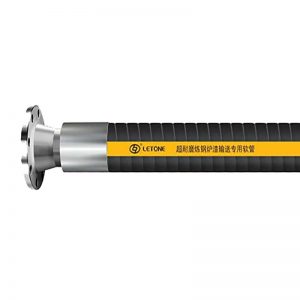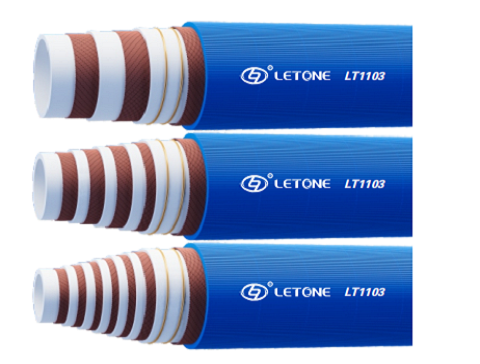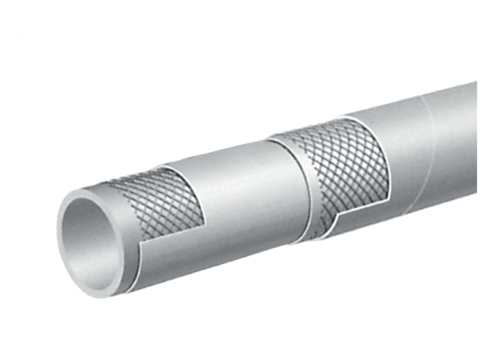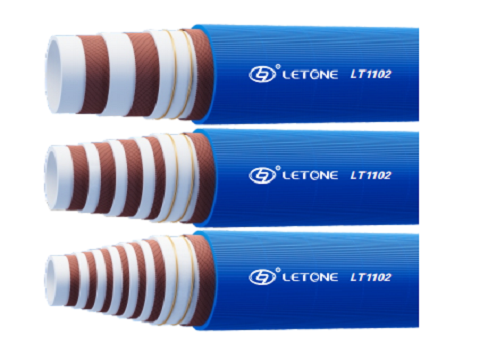Chemical conveying hoses are mainly composed of inner rubber layer, reinforcement layer and outer rubber layer. Among them, the inner rubber layer is in direct contact with chemicals, so it needs to be corrosion-resistant and anti-aging; the outer rubber layer needs to be anti-wear, anti-ultraviolet and other properties. In addition, hoses also need to have a certain degree of flexibility, pressure resistance and high temperature resistance to ensure stable operation in various complex environments.
 2. Material selection
There are a variety of materials for the inner and outer rubber layers of chemical delivery hoses. Common ones include rubber, polyvinyl chloride, polytetrafluoroethylene, etc. The reinforcement layer is usually made of steel wire or fiber braiding to provide sufficient compression resistance and durability. In addition, the selection of hose materials also needs to be adjusted and optimized for different chemicals and environmental conditions.
3. Manufacturing process
The manufacturing process of chemical conveying hose mainly includes the production of inner rubber layer, reinforcement layer and outer rubber layer. Among them, the inner rubber layer and outer rubber layer are usually made by calendering or extrusion process, and the reinforcement layer is made by weaving process. During the production process, strict testing and control are also required to ensure the performance and quality of the hose.
4. Application scenarios
Because chemical transport hoses have excellent corrosion resistance, high temperature resistance and pressure resistance, they are widely used in chemical industry, petroleum, pharmaceutical and other fields. In these fields, hoses are used to transport various corrosive, toxic or flammable and explosive chemicals, providing an important guarantee for the smooth progress of the production process.
In addition to its application in industrial production, chemical transfer hoses also have a wide range of application prospects. For example, in the field of environmental protection, hoses can be used to collect and treat various toxic and harmful wastewater, waste gas, etc.; in the field of agriculture, hoses can be used for irrigation and fertilization; in the field of food processing, hoses can be used To transport various food additives and seasonings, etc.
2. Material selection
There are a variety of materials for the inner and outer rubber layers of chemical delivery hoses. Common ones include rubber, polyvinyl chloride, polytetrafluoroethylene, etc. The reinforcement layer is usually made of steel wire or fiber braiding to provide sufficient compression resistance and durability. In addition, the selection of hose materials also needs to be adjusted and optimized for different chemicals and environmental conditions.
3. Manufacturing process
The manufacturing process of chemical conveying hose mainly includes the production of inner rubber layer, reinforcement layer and outer rubber layer. Among them, the inner rubber layer and outer rubber layer are usually made by calendering or extrusion process, and the reinforcement layer is made by weaving process. During the production process, strict testing and control are also required to ensure the performance and quality of the hose.
4. Application scenarios
Because chemical transport hoses have excellent corrosion resistance, high temperature resistance and pressure resistance, they are widely used in chemical industry, petroleum, pharmaceutical and other fields. In these fields, hoses are used to transport various corrosive, toxic or flammable and explosive chemicals, providing an important guarantee for the smooth progress of the production process.
In addition to its application in industrial production, chemical transfer hoses also have a wide range of application prospects. For example, in the field of environmental protection, hoses can be used to collect and treat various toxic and harmful wastewater, waste gas, etc.; in the field of agriculture, hoses can be used for irrigation and fertilization; in the field of food processing, hoses can be used To transport various food additives and seasonings, etc.







